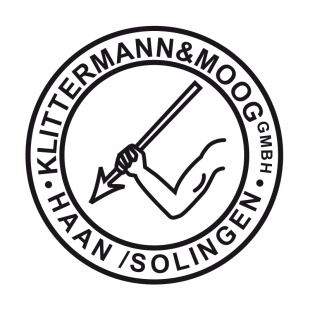Klittermann Haan & Moog Solingen
RZM Number
RZM M7/29 | RZM 324/37/SS | RZM 324/38/SS
Maker
Klittermann Haan & Moog GmbH
Place
Solingen
Reichsgau (SA)
Nrh
Produced (SA)
3000
Klittermann Haan & Moog Solingen
The Klittermann Haan & Moog GmbH, often known as Klittermann & Moog Razor Factory or Steel Goods Factory, was founded in 1920 in Haan near Solingen. The company name derives from Oswald Klittermann, who registered the brand "KLIHASO" (an abbreviation for KLIttermann HAan SOlingen). The company was initially based in Haan and later at Diekerstraße 11 in Solingen, one of the world-famous centers for blade and edged weapons production in Germany. The firm was active until the end of World War II or shortly thereafter, specializing in high-quality cutlery, razors, and during the Nazi era, political daggers and bayonets for NSDAP organizations.
In 1935, Klittermann Haan & Moog received the RZM code M7/29 from the Reichszeugmeisterei, which was assigned for the production of edged weapons in the Third Reich. This code was also assigned to Jacobs & Co. from July 1938, suggesting possible cooperation or joint production – particularly for SS service daggers. The RZM code 324/##/SS is also associated with Klittermann, although primarily attributed to Jacobs. The company produced a variety of bladed weapons, including early SA and NSKK daggers, transitional daggers from 1939, as well as Hitler Youth knives and some dress bayonets. Particularly noteworthy are the SA service daggers (Sturmabteilung), produced in an estimated quantity of about 3,000 pieces. These daggers are rated with a SA Dagger Rarity of 3/5 as moderately rare and highly valued by collectors, often featuring the motto "Alles für Deutschland" and Gau markings like "Nrh" (for Niederrhein).
Regarding the SS service daggers, produced under the motto "Meine Ehre heißt Treue!", there are indications of joint production with Jacobs & Co., where Klittermann used a unique etching template for the RZM M7/29 stamp – recognizable by a decorative "M". The company advertised in magazines like "Die Klinge" with products ranging from razors to sheathed knives. After 1936, RZM codes increasingly replaced traditional manufacturer logos on political daggers to standardize production.
The logo of Klittermann Haan & Moog was diverse and reflected creative branding. Early trademarks showed a sleeping elf under a toadstool being tickled by a fairy – a playful motif highlighting the finesse of the razors. Another variant was "THE SAVOY", flanked by two griffins symbolizing strength and elegance. The later, more well-known logo consisted of a bent arm holding a spear, surrounded by the inscription "Klittermann & Moog G.m.b.H. Haan b/ Solingen". These emblems underscored the artisanal tradition of Solingen and made the products easily recognizable.
Today, the products of Klittermann Haan & Moog are coveted collectibles that embody the industrial and historical development of the Solingen manufacturer history in the edged weapons industry. The company represents the transition from civilian cutlery to military and political weapons during the Nazi era, making it an important chapter in the encyclopedia of Solingen manufacturers.


![Long Army Dress Bayonet [K98] by Anton Wingen Solingen](https://www.dg.de/media/images/product/sidebar/bayonet-seitengewehr-k98-anton-wingen-solingen-3944-1.jpg)





![SS Dagger [Late Model] with Exclamation Point Motto by RZM M7/29 SS Dagger [Late Model] with Exclamation Point Motto by RZM M7/29](https://www.dg.de/media/images/product/thumb/ss-dienstdolch-dagger-ausrufezeichen-rzm-m7-29-Haan-klittermann-moog-solingen-3903-1.jpg)

![SS Dagger [Late Model] with Exclamation Point Motto by RZM 324/37 SS SS Dagger [Late Model] with Exclamation Point Motto by RZM 324/37 SS](https://www.dg.de/media/images/product/thumb/ss-dienstdolch-dagger-ausrufezeichen-rzm-324-37-ss-2910-1.jpg)
![SS Dagger [Late Model] with Exclamation Point Motto by RZM M7/29 SS Dagger [Late Model] with Exclamation Point Motto by RZM M7/29](https://www.dg.de/media/images/product/thumb/ss-dienstdolch-ausrufezeichen-rzm-m7-29-2665-1.jpg)
![SA Dagger [Middle Version] with Hanger by RZM M7/29 (Klittermann Haan & Moog) SA Dagger [Middle Version] with Hanger by RZM M7/29 (Klittermann Haan & Moog)](https://www.dg.de/media/images/product/thumb/sa-dolch-dagger-rzm-m7-29-klittermann-haan-moog-2297-1.jpg)
![SS Dagger [Late Model] with Exclamation Point Motto by RZM M7/29 SS Dagger [Late Model] with Exclamation Point Motto by RZM M7/29](https://www.dg.de/media/images/product/thumb/ss-dolch-dagger-rzm-m7-29-2104-1.jpg)



 Exclusive offers 10 € voucher when you sign up to our newsletter.
Exclusive offers 10 € voucher when you sign up to our newsletter.


